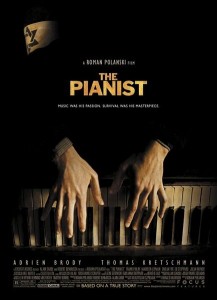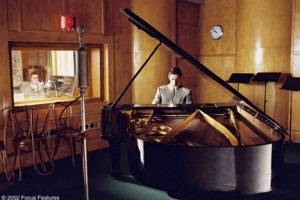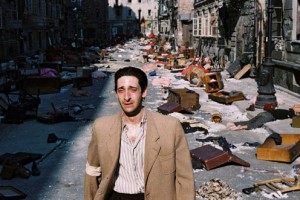The Pianist (2002)
Dir: Roman Polanski (See Note 1)
Stars: Adrian Brody, Emilia Fox, Ed Stoppard and Jessica Kate Meyer
The Pianist is one of those titles that I had seen only once, but I remembered as a great film. I was eager to watch it again once I recorded it with my DVR, and over the weekend, I watched it beginning to end. Upon a second viewing, I feel like this title is one of the essential WWII films you should see, and I’ll explain why.
The story concerns Wladyslaw Szpilman, a Polish concert pianist extraordinaire: the opening frame on this character reveals a skinny man in a tailored suit, concentrating on the piano concerto he’s playing within the sound booth of a Warsaw radio station. In the distance, we can hear bombs bursting and buildings exploding. These explosions get progressively closer… and closer until we see the sound technicians in the recording booth urgently talking to each other, then motioning for Szpilman to stop. Then, we see Szpilman’s annoyed shaking of the head back at them – and then the sound technicians leave the booth! Szpilman, perfectionist that he is, continues: and then the wall explodes and showers his sound booth with glass.
This opening scene sets the tone of the entire picture. This is only 1939 when we first meet Szpilman. From here on, there is no guarantee of safety. There is no promise that Szpilman or the person walking next to him will live to see tomorrow. There’s nothing to assure him or his friends of seeing their families again. Things just don’t make sense! And this was Szpilman’s daily reality for more than six years as the Nazis invaded, occupied and destroyed his home town.
Since we all know the history, I will tell you about the unique elements of The Pianist that separate it from other WWII epics, making it a very niche and educational tale (you’ll note I hesitate to call it entertaining). Let’s start with the unbelievable resolve amongst the Szpilman family to stay put. It was as if the family was collectively saying, “Leave Warsaw? Our home? Never!” The family didn’t give a damn how many Nazi thugs smacked them on the way home from work, evicted them from their home, shoved them in a forced ghetto, made them wear insignia on their arms or whatever. Warsaw was home to the Szpilmans and as portrayed in this film, it was never, ever an option to leave. I found this upsetting at first: “go to New York, for crying out loud!”, I yelled at the screen. But, they didn’t. I didn’t understand this kind of resolve watching the film and I’m at a loss to understand staying in harm’s way now (even in reflecting on the film): however, I sure respect the familys’ decision to do so.
The handling of violence in the film is more than noteworthy; it’s an announcement made on a bullhorn to all film makers to please, please, please research your subject matter and ensure the violence depicted in your story fits the theme and feeling you’re trying to portray overall. Let me provide an example: imagine a view of a Warsaw street from four floors up in an apartment building. There is a German hospital immediately across the street with a few guards armed with rifles: Szpilman is living in this building at one point in the story because, as one of the people hiding him says, “you’re safest in the lion’s den since it’s the last place they’ll look.” Anyhow, in this scene, we’re looking outside for a long moment before we see three or four guys in trenchcoats round the corner, then reveal “burp” machine guns and mow down the German guards! Then, there’s a bazooka shot from somewhere within our building right into the hospital, followed by a huge explosion!
Two points here: first, all of this action is shown in long shot, as in you’re constantly leaning towards the screen while watching the film as if to say, “What just happened?” Second, all of the violence explodes and then is over – and you’re just left to digest it like poor Szpilman! I was impressed that much of the terror that Szpilman witnessed seemed to indeed be from his perspective, in long shot, from where he was sitting, which many times made it all the more horrific.
On this note of perspective, let’s talk about Production Design (capitalized intentionally) for a moment, shall we? (See Note 2) There are infinite scenes in this film with Szpilman, his family, his friends and sometimes his enemies shot in the foreground: but it’s the backgrounds that make The Pianist so authentic, and raise that feeling of uneasiness you’re constantly feeling as a viewer from Act 2 onward. There were several times during the course of the film where I thought to myself, “Is that a corpose in the background?” The setting of this movie, the “background artists” as “extras” are sometimes called, the attention to detail of the trains, the Nazi costumes and weapons, the blown-to-bits buildings, the empty 1930s era suitcases, ET CETERA, really blew me away.
I’ve described how The Pianist kind of makes you feel anxious as you watch it, as in you don’t know which character is going to be lost or shot or beaten next: I think this is a really valuable film because it’s so different from other WWII epics in its setting. This is the story of how civilians were left to deal with Nazi occupation and abuse the likes of which I can’t imagine. I think you’ll agree that many WWII stories deal with soldiers in the field, their training, the battles and the shock of returning to civilian life. What separates The Pianist from the others is it forces you to think about yourself, the peace loving citizen… what if tanks and armed troops rolled down your street?
Note 1: I am not going to discuss Mr. Polanski personally, nor his winning the Best Director Oscar for 2002.
Note 2: I see the nominees for Art Direction in 2002 were Frida, Gangs of New York, Chicago, Road to Perdition and Lord of the Rings: The Two Towers… Uh huh. Frida? Great film. Not taking anything away from it. Loved the passion that Ms. Hayek put into it. However, THIS film, The Pianist had some Art Direction that was essential to telling the story from Szpilman’s perspective, was enormous in scope and was detailed to the nth degree. Frida for Best Art Direction. Let the head scratching over Oscar nominees continue.



